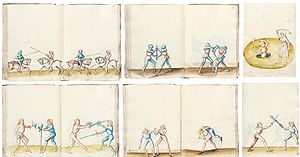
MS 862
Encyclopedia

Fechtbuch
Martial arts manuals are instructions, with or without illustrations, detailing specific techniques of martial arts.Prose descriptions of martial arts techniques appear late within the history of literature, due to the inherent difficulties of describing a technique rather than just demonstrating...
dating to ca. 1500. It is influenced by Paulus Kal
Paulus Kal
Paulus Kal was a 15th century German fencing master. In 1460, he wrote a combat manual describing the art of fencing .-Literature:...
and Peter Falkner
Peter Falkner
Peter Falkner is the name of a German fencing master, active in the late 15th century , influenced by Paulus Kal.He is the author of a fechtbuch, now KK 5012, at the Kunsthistorisches Museum, Vienna....
, and was in turn drawn upon by Jorg Wilhalm
Jörg Wilhalm
Jörg Wilhalm was an early 16th century German fencing master, hatmaker, and citizen of Augsburg.There are six fechtbuchs attributed to Wilhalm:* 1522 Cod.I.6.4°.5, 47 folia, Augsburg University library, bought by Paulus Hector Mair in 1552....
(1520s).
The manuscript was up for auction at Sotheby's
Sotheby's
Sotheby's is the world's fourth oldest auction house in continuous operation.-History:The oldest auction house in operation is the Stockholms Auktionsverk founded in 1674, the second oldest is Göteborgs Auktionsverk founded in 1681 and third oldest being founded in 1731, all Swedish...
in 2005.
It has been acquired in 2008 by the Musée National du Moyen Age - thermes & hôtel de Cluny, in Paris, where it is currently on display (inventory number CL23842).
Contents
- fols. 12r-57v, fencing with the longswordLongswordThe longsword is a type of European sword designed for two-handed use, current during the late medieval and Renaissance periods, approximately 1350 to 1550 .Longswords have long cruciform hilts with grips over 10 to 15 cm length The longsword (of which stems the variation called the bastard...
, 92 pictures, 37 of them with captions, showing two young men in combat, one dressed in pale red, one in blue. - fols. 60r-69v, fighting with großes Messer, 20 pictures, no captions, the same two young men in chivalric combat.
- foll. 72r-87v, fighting with daggerDaggerA dagger is a fighting knife with a sharp point designed or capable of being used as a thrusting or stabbing weapon. The design dates to human prehistory, and daggers have been used throughout human experience to the modern day in close combat confrontations...
s, 32 pictures, one caption, the two young men again. - foll. 95r-114v, grapplingGrapplingGrappling refers to techniques, maneuvers, and counters applied to an opponent in order to gain a physical advantage, such as improving relative position, escaping, submitting, or injury to the opponent. Grappling is a general term that covers techniques used in many disciplines, styles and martial...
, 40 pictures, no captions, the same two young men demonstrating holds and throws and a hold to immobilise two assailants at once (fol.114v). - foll. 118r-131v, fighting with a sword and bucklerBucklerA buckler is a small shield, 15 to 45 cm in diameter, gripped in the fist; it was generally used as a companion weapon in hand-to-hand combat during the Medieval and Renaissance, as its size made it poor protection against missile weapons but useful in deflecting the blow of...
, 28 pictures, no captions. - foll. 133v-148r,n fighting on horseback, 29 pictures, including competing with lances (fols. 133v-136v), swords (fols.137r-140v), wrestling on horseback (fols. 141r-146r, including wrestling the opponent's horse too), and fighting when one contestant is on horseback and one on the ground (fols. 146v-148r).
- fols. 149r-178v, 58 pictures, armouredPlate armourPlate armour is a historical type of personal armour made from iron or steel plates.While there are early predecessors such the Roman-era lorica segmentata, full plate armour developed in Europe during the Late Middle Ages, especially in the context of the Hundred Years' War, from the coat of...
combat, two with captions, fols.149r, 150r with lances), mostly with longswords, a scene of wounding on fol. 166r. - fols. 180r-181v, 4 pictures, no captions, franconianFranksThe Franks were a confederation of Germanic tribes first attested in the third century AD as living north and east of the Lower Rhine River. From the third to fifth centuries some Franks raided Roman territory while other Franks joined the Roman troops in Gaul. Only the Salian Franks formed a...
judicial duels with shields and clubs, shields alone, and shield against swiss daggerSwiss daggerThe Swiss dagger is a distinctive type of dagger used in Switzerland and by Swiss mercenaries during the 16th century.It develops from similar dagger types known as basler which were in use during the 14th and 15th centuries...
. - foll. 183r-191v, miscellaneous combats, 17 pictures, no captions, including poleaxes, maces, shieldShieldA shield is a type of personal armor, meant to intercept attacks, either by stopping projectiles such as arrows or redirecting a hit from a sword, mace or battle axe to the side of the shield-bearer....
s, battle-axes and lanceLanceA Lance is a pole weapon or spear designed to be used by a mounted warrior. The lance is longer, stout and heavier than an infantry spear, and unsuited for throwing, or for rapid thrusting. Lances did not have tips designed to intentionally break off or bend, unlike many throwing weapons of the...
s, some armoured. - fols. 194r-v, 2 pictures, two men in loincloths with swords, and a woman with a ball on a chain fighting a man with a club standing in a pit (franconian judicial duels).
- fols. 195r-121v, on fighting in full armour, 36 pictures, one caption, fighting with swords but often held from the middle or the other end (a style of fighting known as Gladiatorial, derived from a manuscript now in the Jagellonian library in Cracow, formerly in Berlin; cf. H. Wegener, Miniaturen-Handschriften der Preussischer Staatsbibliothek zu Berlin, Die Deutschen Handschriften bis 1500, V, 1928, pp. 61-2).
External links
- Select images from the manuscript, courtesy of the Musée National du Moyen Age.

